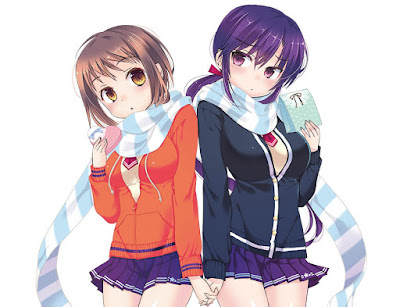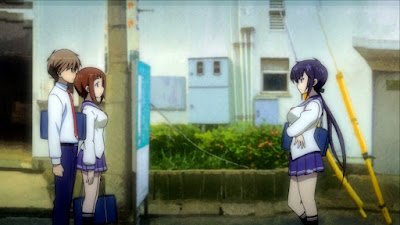Hyperdimension Neptunia Review
 |
| The four goddesses of Hyperdimension Neptunia Green Heart, White Heart, Black Heart, and Purple Heart (the female lead) |
The story of Hyperdimension Neptunia starts off with the four goddesses of the world of Gameindustri battling for thousands of years gaining little or no ground. To break this endless stalemate, the goddess White Heart (Nintendo) suggests that the three of them team up together to take one of the goddesses out of Celestia. Black Heart (Sony) who is battling Purple Heart (Sega) gets irritated by Purple Heart’s egging on. With Green Heart’s (Microsoft) suggestion, the three goddesses decide to take out Purple Heart. Irritated that she had no say in this situation, Purple Heart brags that she could take out all three goddesses, and then proceeds to lose against the other three goddesses. Neptune wakes up on Planeptune with injuries all over her body. Having fallen from the sky, she doesn’t remember anything about herself and her past. Helped by the Compa (Compile Heart), she decides to go all over the world of Gameindustri since she believes she is the only one who can save it. Over the course of the game, she goes into the lands of Lastation (Black Heart’s domain), Lowee (White Heart’s domain), and Leanbox (Green Heart’s domain), trying to change the world around her.
 |
| Neptune (Purple Heart) |
Over the course of the game, Neptune has two sidekicks Compa (Compile Heart) and Iffy (Idea Factory). Compa is the personification of everything that is wrong with moe. To be honest, I had no idea that I could hate moe, until I met Compa in Hyperdimension Neptunia. She is a useless character whose voice is grating, she has no redeemable qualities whatsoever. The moment I had the option of removing her from my party, I removed her. Iffy is a much more interesting character, she is a rebel who was born in one land but is loyal to the Goddess Green Heart. She is the serious girl who always keeps Neptune and Compa in line. Iffy always talks down to the other two, but deep down inside she cares about the both of them. The levelheaded and logical person in the group, she always finds herself outnumbered by Neptune’s silly antics.
 |
| Puple Heart and Black Heart |
The flow of the game is simple, the gamer views an event that is akin to a visual novel. There are gorgeous polygonal models using cell-shading of the characters talking on a static background. After the event is seen, a dungeon or another event opens up. The dungeons are quick affairs with simple goals, like reach the destination, find x number of items, or defeat the boss. In each world there are around five or six template dungeons, but each dungeon map is different. After the dungeon you can see another event that moves the story forward. The town is not explorable, using only a menu to navigate between events, dungeons, and shops.
The graphics in Hyperdimension Neptunia are fairly low-end. It is definitely not a game that pushes the Playstation 3 to its limits. The dungeon polygonal models are nice and they are a great transition from the original art. Image quality is not as good as Ar Tonelico 3, with its heavy anti-aliasing and higher polygonal models. Compile Heart should have used some of that extra PS3 power and push for heavy anti-aliasing and higher polygonal models. The graphics are inconsistent; because they dungeons do look nice, but it is jarring to have entire sections of the dungeon pop up out of nowhere. There is one incredible aspect when it comes to graphics, and that is the character models used in the event sequences. The character models are cell-shaded graphics that are a perfect representation of the original character design. At first I thought that it was 2D art, but the breathing and the mouth movements show that the character models are cell-shaded 3D graphics. The character models don’t do much except breathe, but it looks great. I love the character designs, and I am happy to see that none of the awesome design was lost when transition from the character design to the event 3D models.
Music in any game highlights important sequences and it can bring the game to a higher level of immersion. There are some great pieces of music, like the battle theme in the world of Lowee. The overall soundtrack is weak and it would have been nice if they had used that Gust connection to create a better musical score. In the events, about 5 pieces of music is used for the entire game, and one track is used over and over. It would have been nice to see more variety when it came to event music.
 |
| Noire (Black Heart) |
 |
| Neptune in her normal form |
The issue with Hyperdimension Neptunia is you have to get past all the juvenile humor to get the satire in the game. Namco’s Tales franchise is known for having a couple of boob jokes about the token well-endowed female, but Hyperdimension Neptunia takes it to a whole new level. Nisa, the hero of Gameindustri is the butt of many jokes with her washboard chest. I know that when Neptune transforms she transforms into a beautiful, sexy, buxom vixen that is the envy of most women in the world of Gameindustri, but the running gag gets old when Iffy is joking about Neptune’s “Boobalicious” outfit so many times. In fact, the boob jokes are so rampant that in the first 2 minutes you already have enough of those that would make Team Symphonia blush. Green Heart comments that a healthy chest shows that she is a great goddess, and that White Heart and Purple Heart fail in that regard, only to have White Heart respond by calling her “thunder tits.” The running gag goes throughout the whole game, all the way to the very end. They were definitely not going out of their way to hide their fascination with the female anatomy.
Once you can get past the low production values and the juvenile boob jokes, Hyperdimention Neptunia is a great game. There is an incredible character dynamic and it has a strong cast of likable characters. The dungeons move fast so it is not an experience that drags on. The game has a wonderful battle system that is very customizable and so addicting. Hyperdimention Neptunia’s satire of the gaming and anime industry is excellent; there are so many references that would put a smile of any fan. The game is what you make of it, and overall Hyperdimension Neptunia is a great experience that has some flaws. It is a game with a unique concept of the console war, too bad that the real Neptune is nowhere to be found to knock some sense into Sony, Nintendo, and Microsoft.






Comments